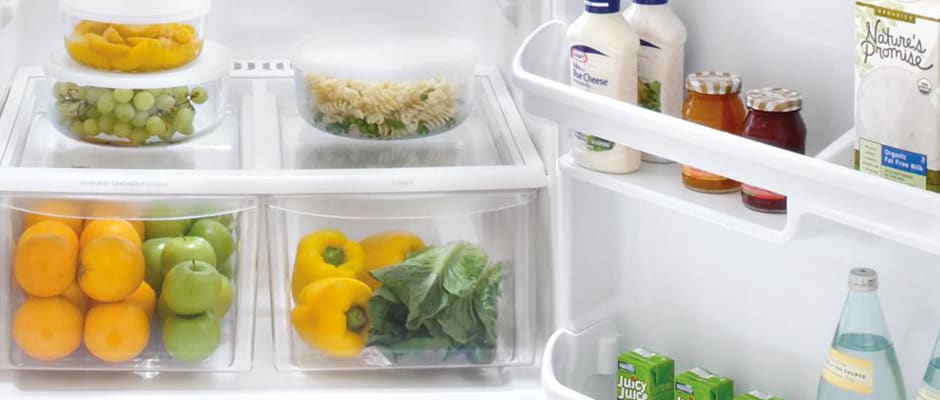Pros
Cons
Introduction
Design & Usability
{{section_header}}{{section.name}}{{/section_header}}
It looks clean and polished, but upon closer inspection, things like weld lines and rough edges become clearly visible.
The front of the unit has a stainless steel finish with an unusually prominent grain. Fingerprints won't show up much as a result, but it also means you may have a hard time getting it to match any other stainless appliance already in your kitchen. In addition, weld spots and rough patches are visible upon a closer examination of the seams and edges.
As unusual as the outside may be, the interior has about as straightforward a design as one could find. The only surprising design choice involves the humidity controls for the vegetable drawers; instead of being placed on the front edge, as is most common, they're found on the sides, running perpendicular to the front. You'll have to be careful when putting things on the bottom shelf, since you could run the risk of nudging the controls and altering the interior of the crispers. The spartan freezer just has a lone shelf to break up the monotony.
{{photo_gallery "Front Photo", "Fingerprints Photo", "Handle Photo", "Handle Detail Photo", "Water/Ice Dispenser Photo", "Water/Ice Dispenser Controls Photo", "Water/Ice Dispenser Detail Photo", "Interior Photo", "Refrigerator Main 1 Image", "Refrigerator Main 2 Image", "Refrigerator Main 3 Image", "Water Filter Photo", "Refrigerator Door 1-1 Image", "Refrigerator Door 1-2 Image", "Refrigerator Door 1-3 Image", "Refrigerator Door 2-1 Image", "Refrigerator Door 2-2 Image", "Refrigerator Door 2-3 Image", "Freezer Main 1 Image", "Freezer Main 2 Image", "Freezer Main 3 Image", "Freezer Door 1 Image", "Freezer Door 2 Image", "Freezer Door 3 Image", "Ice Maker Photo", "Back Photo", "Back Detail Photo", "Sides Photo", "Side Detail 1 Photo", "Side Detail 2 Photo", "Fridge Temperature Image", "Freezer Temperature Image", "Vegetable Drawer Photo", "Vegetable Drawer Controls Photo", "Ease of Access Photo", "Controls Photo", "Cleaning Photo", "Other Features Photo"}}
Features
{{section_header}}{{section.name}}{{/section_header}}
Without any extra features or options for customization, this fridge is about as straight-forward as they come.
As is the case with all top freezers, you have to bend down to get to anything in the crisper drawers, but that’s nothing new. Other than some occasional stooping, getting to any food item regardless of where it's located should be a cinch. The shelves and drawers are light enough to remove and clean. However, the top two shelves only have spill protection on the front and back, meaning anything that spills will easily drip down the sides, at which point the crisper drawers would have to be removed to get to the mess. Similarly, the door shelves are easy to wipe clean, but have no spill protection whatsoever.
The controls for the fridge and freezer are separate, a nice touch for this type of budget model. The two identical dials turn left and right on a scale of Cold to Colder, with a Normal setting marked in the middle. There's no actual degree scale, however, so pull out your personal thermostat if you want to double check the internal temperatures. The freezer control is located at the center of the back wall, where access is determined by how much food is placed in front of it.
Performance
{{section_header}}{{section.name}}{{/section_header}}
Despite the somewhat questionable controls, the Frigidaire delivered solid performance scores across the board.
This is a problem with controls that utilize an arbitrary scale. Even though we calibrated it to what is marked as the Normal setting, the temperatures ran a few degrees warmer than is ideal. Luckily, it was consistent throughout the entire refrigerator section over time, so simply turn the control knob down a bit and you should be fine.
While everything about the fridge was just average, the freezer was downright poor. We turned the controls down to the lowest setting, and even then, this freezer never reached the ideal zero degrees Fahrenheit. Additionally, the sensors we use to record temperature data revealed that, over the course of three days, temperatures fluctuated significantly. Small amounts of freezing and thawing caused by that degree of fluctuation is what leads to freezer burn.
As far as the vegetable drawer goes, moisture retention was average. Produce should be fine here, but only as long as you don't let it sit for a week and a half.
Conclusion
{{section_header}}{{section.name}}{{/section_header}}
It may not have the best performance, but for the price, this Frigidaire manages to give you more than you'd be paying for.
A solid top freezer for shoppers with a budget, the Frigidaire FFHT1817LS is a model based on simplicity. It may not have much flair or internal gadgets, but it makes up for that with solid energy performance and reasonable storage space. A potentially good fit for college grads that will eat what they put in the freezer almost immediately, we found this model for as low as about $600—about $250 lower than the MSRP—making it one of the cheapest stainless fridges available. Folks who place a lot of importance on design should keep in mind that, up close, it’s one of the cheapest looking stainless fridges available.
Science Introduction
{{section_header}}{{section.name}}{{/section_header}}
Generally speaking, this is a very average fridge. It's got a few high points, and a few low, but most land squarely in the middle.
Temperature Performance
{{section_header}}{{section.name}}{{/section_header}}
Very reliable temperature output, as long as you can find the right settings.
The fridge ran a bit warm throughout the whole compartment, which is more of an issue with the thermostat than anything else. The good news is, everything was consistent over both time and space; as long as you've got a personal thermometer that you can use to calibrate this machine, it'll do a fine job.
From top to bottom, temperatures in the freezer remained very close together—5.4 degrees Fahrenheit at the top, down to 4.92 degrees at the bottom—though it had the same issue as the fridge. Definitely turn the controls down below the "normal" setting if you want things done right. Inconsistencies in freezer temperature over time raises a bit of a red flag, however. There were shifts ranging from three quarters of a degree up to as much as 1.27 degrees; given how small the freezer is, that's more shift than we like. Keep an eye for freezer burn, because it's definitely coming.
{{photo_gallery "Science Section 1 Images"}}
Moisture Retention
{{section_header}}{{section.name}}{{/section_header}}
Average moisture loss in this fridge's crisper drawers.
The Frigidaire had slightly better-than-average crisper drawers. The substance simulating artificial food that we use to test humidity retention registered a 0.19 grams per hour moisture loss at the highest humidity setting. We've seen much better results, but we've also seen much worse.
{{photo_gallery "Science Section 2 Images"}}
Freezing & Thawing
{{section_header}}{{section.name}}{{/section_header}}
A low-tech freezer that gets the job done in an acceptable amount of time.
Even though the specific temperature inside the Frigidaire’s freezer varied over time, it only took 1 hour and 36 minutes for the items at room temperature to freeze, which is more or less about average. Consumers shouldn't notice much of a degradation in texture when freezing items like meat. The insulation is fantastic, too; after 36 hours without power, this freezer hadn't even cracked 25 degrees Fahrenheit.
{{photo_gallery "Science Section 3 Images"}}
Storage Space & Energy Efficiency
{{section_header}}{{section.name}}{{/section_header}}
A reasonable amount of storage space with more than reasonable efficiency ratings
Keep in mind that we measure space that can actually be used to store things, accounting for any space taken up by shelves, light bulbs, and any other obstructions. The main refrigerator cavity plus door shelves combine to yield 9.02 cubic feet of storage space. That's pretty good for a fridge this size, as is the freezer. That compartment clocked in at 3.35 cubic feet, also including the door shelves.
The best part about this Frigidaire's performance was its energy efficiency. Using a standard rate of $0.09 kW-h, the Frigidaire FFHT1817LS will cost $27.17 per year, which is a very low rate. Pairing the energy usage to the storage space, it turns out that this efficient little devil only need 0.07 kW-h per cubic foot, an incredibly low amount.
{{photo_gallery "Science Section 4 Images"}}
Other Tests
{{section_header}}{{section.name}}{{/section_header}}
{{photo_gallery "Other Tests Images"}}
Meet the tester
Matthew is a native of Brockton, Mass., and a graduate of Northeastern University, where he earned a degree in English and Theatre. He has also studied at the Gaiety School of Acting in Dublin, Ireland, and spends time pursuing a performance career in the greater Boston and Cambridge area.
Checking our work.
Our team is here to help you buy the best stuff and love what you own. Our writers, editors, and experts obsess over the products we cover to make sure you're confident and satisfied. Have a different opinion about something we recommend? Email us and we'll compare notes.
Shoot us an email

